Fenton (Shelton) House & the Denison Family
The early history of this imposing building that stands in the centre of Woburn Sands High Street is closely interwoven with the Denison family. Arabella Denison succeeded to the Manor of Wavendon through her husband, Isaacson Denison, a Principle of Magdalen Hall, Oxford. The Denison’s had held Wavendon since at least 1735. Their son, William, was the Rector of Cublington, a small village to the west of Leighton Buzzard, and in 1808 he married Caroline Aveling, daughter of the vicar of Aspley Guise. Arthur Parker, the late historian for Woburn Sands, believed it was Rev. Denison who purchased the land to the west of the main road through Woburn Sands from the farmer Thomas Hart, then pulled down some old farm buildings and built his large mansion.
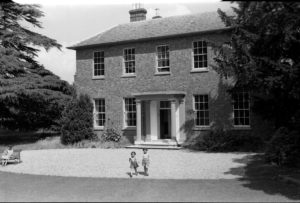
Evelyn Wright wrote about the house in “St. Michael’s, Woburn Sands, The Church, The Parish and The People”, published in 1993:
“There are several contradictory theories about the age and the history of the house, but a brick bearing the date 1774 and the style of the building would seem to place it firmly in the Georgian period… The grounds of Fenton house reached right down to Hardwick Cottage. There was an open meadow, with no buildings in sight except for the old 17th century cottage used as the Quaker Meeting Room, which stood on the site of the present Library [since removed to the High Street] … From the High Street [it] may appear rather plain and forbidding, but this was the back of the house. The carriage gates to the right (where the road now goes down to Shelton Court) opened onto a wide gravel driveway sweeping round to the front of the house with its imposing portico and entrance door. The well-proportioned sash windows looked out across a lawn fringed with cedars and evergreens to a small park beyond. And beyond that, amongst the trees there would be glimpses of Hardwick Cottage itself.”
The “1774” brick mentioned is not a proper date stone, it is more like graffiti and therefore cannot be taken with any certainty to be the actual date of the building.
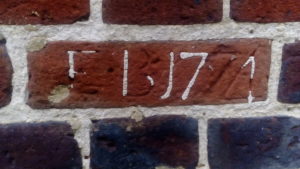
Arthur Parker saw the deeds for the house, and left notes showing that Thomas Hart, farmer of the original farmstead based at The Swan, sold the ground to William Denison in 1820.
The earliest mention of Fenton House in the digitised collections of the online British Newspaper Archives is from 1830. The Rev. Denison wanted to stop not only the poachers from stealing his game, but also to prevent the various local Hunts from using his land, so he published a notice in the Northampton Mercury on September 11th:
“MANOR of WAVENDON, in the County of Buckingham. QUALIFIED Persons are requested NOT TO SPORT on the Lands in the MANOR of WAVENDON, Bucks, belonging to the Rev. WILLIAM DENISON, the Lord of the said Manor. All qualified persons found sporting thereon, will be prosecuted. Fenton House, Wavendon, Aug. 30th, 1830.”
Four years later, Rev. William passed away at his house on 5th September 1834. The Bucks Gazette recorded that he was in his 72nd year. The house was passed to his eldest son, William Henry. On the 11th February 1835, William Henry’s younger brother, Robert Isaacson Denison, married Sarah the second daughter of Rev. R. Pain, who ran the Aspley Guise Classical Academy. (Northants Mercury 21/02/1835).
A few years after, Fenton House was put up for sale. Did William Henry not want it, or was it to settle inheritance matters? On 1st September 1838, this advert appeared in the Beds Mercury:
“FENTON HOUSE, WOBURN SANDS IN THE PARISH OF WAVENDON BUCKS. For Sale By Auction BY J. S. DEVEY, at the GEORGE HOTEL, WOBURN, on FRIDAY, the 21st Day of SEPTEMBER, 1838 at Four O’Clock in the Afternoon.
THE MANSION called Fenton House and Premises at Woburn Sands, in the Parish of Wavendon, Bucks. Adjoining the Manchester Road, within two miles of the Town of Woburn, Beds. and forty-four from London.
The House is substantially built and comprises Entrance Hall, small Study, 14ft. by 8ft. 6, Breakfast and Dining Rooms, each 19ft. 9 by 15ft. 9 and 12ft. high, well fitted Butler’s Pantry, Kitchen, Larder, Dairy and Cellarage, Drawing Room 20ft. by 17ft. and 11ft. 6in high; four Good lofty Bed Rooms and Three Dressing Rooms; Two Servants Rooms; Linen and Store Closets &c., &c.
Attached are Scullery with Engine force Pump and Excellent Water, well fitted Brewhouse, Roomy Laundry, and Wash-house, 4 stall stable and Loose box, Double Coach-house, &c.
The Garden and Ground adjoining contain Two Acres more or less.
The Property is FREEHOLD; it is situate in a good neighbourhood within a short distance of the Oakley and Grafton hounds, about four miles distant from the Railway Station at Denbigh Hall, and about six miles from the intended Great Station at Wolverton.
Possession of the Premises may be had at Lady Day next. May be viewed on application to Mr. Yardley, the present occupier, and further information may be obtained at the offices of Mr Green, Solicitior, Woburn; Messrs Keene and Wright, Solicitors, 16 Furnival’s Inn, London; Mr Shouler, Wavendon and of the Auctioneers, Woburn.”
There was no report of the actual sale, but as William Henry continued in occupation, perhaps the reserve price was not met. Sadly, the 1841 census data is too feint to read to see if the house is mentioned by name. In October 1845, the late Reverend Denison’s only daughter, Arabella Frances, passed away. She had married Dr E. D. Walker and lived in West Teignmouth. (Morning Post: 03/11/1845)
In a long press report published in the Bucks Herald of 26th October 1850, a meeting examining the prospects of establishing a cattle market at Leighton Buzzard was reported. Many local landowners and farmers were name-checked in the piece, including “Mr. William Denison, Esq., of Fenton House”.
In the 1851 census, Fenton House is listed, with the occupants: William Henry Denison, 40, a “Landed Proprietor,” with his wife Sarah D’Oyle Denison, 35, from Reading, along with Caroline Gladys, 26, from Hurst in Berks., and Martha Adams,15, from Oxford, both servants.
Bedfordshire Archives & Records Service (BARS) holds some correspondence from an “Elizabeth Lawrence of Fenton House, Woburn Sands” (SF1/402/18) regarding the proceeds of sale and how much there will be for the creditors, dated 2nd November 1855. When William Henry Denison came third in Class XV at the Vale of Aylesbury Poultry Show in January 1856, he was now described as “of Hardwick Cottage, Woburn, Beds.” An indication that perhaps the Denison family had now moved out of Fenton House into their smaller property nearby, Hardwick Cottage, and let Fenton House out to the Lawrence family?
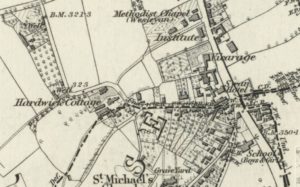
William Henry certainly still owned Fenton House, as it was included in his draft will, written in August 1857. (BARS HN10/270/Denison1) Appointing John Samuel Tanqueray of Hendon, gentleman and Rev. Truman Tanqueray of Tingrith to be his executors, he left:
“- to my wife Sarah D’Oyley Denison £100 and all household furniture, plate, linen, books, china etc.;
– to my executors the residue of my personal estate upon trust for sale upon the same trusts as those concerning my real estate;
– to my executors Fenton House, Wavendon, with outbuildings, yards, gardens etc. also my manor in Wavendon and all real estate in Wavendon and Bow Brickhill and Aspley Guise upon trust for sale with consent of parties in my marriage settlement regarding those lands comprised in the settlement;
– My trustees to stand possessed of sale monies, rents and profits etc. upon trust to pay an annuity of £200 to Sarah D’Oyley Denison as provided for in the marriage settlement;
– after the death of Sarah D’Oyley Denison, one tenth of trust monies to be invested and paid to those she might appoint in her will, if she did not appoint anyone then the one tenth to sink into the residue;
– The trustees to pay income from half the residuary trust monies as an annuity to Frances Harriet Walker and John William Dering Walker, children of my deceased sister Arabella Walker in equal shares when over 21;
– The trustees to pay income from other half of the residuary trust monies to Francis Sarah Boulger, Edith Jane Boulger, Mary Seawell Boulger and George Simonds Boulger, children of my wife’s sister Frances Boulger when attaining 21 and in equal shares, remainder to their respective issue if any.”
The mention of “all real estate” in the area, is helpfully detailed in a plan produced in 1859: “Plan of Estates situate in the Parishes of Woburn, Aspley Guise and Bow Brickhill in the counties of Bedford and Buckingham belonging to William H. Denison Esq., 1859” by J. Woodward, land Surveyor, of Woburn, to a Scale of 6 chains to 1 inch. (BARS: HN1/36)
The 1861 census is very short on specific house details for Woburn Sands. The Denison’s are there, but no house name is shown, so it could have been either Fenton House or Hardwick Cottage that was being referred to. The servants had both changed since 1851:
William Henry Denison, 50, Land Proprietor
Sarah D’Oyley Denison, 45, Proprietors Wife
Lucy Young, 23, House servant, Aspley
Rebecca Biggs, 35, Cook, from Weston, Wilts.
Fenton House was put up for sale again in 1862. The description is principally the same as the last sale in 1838. Although a different sale location is named from the last auction, it was actually the same place, as the Hotel in Woburn had changed name since then. The Bucks Herald, 26th April:
“By Messrs. THOMAS & GEORGE GREENE. BUCKINGHAMSHIRE. VALUABLE FREEHOLD ESTATE. Capital Family Residence, Gardens, and Pleasure Grounds, 240 ACRES OF SUPERIOR SWARD AND ARABLE LAND, Situate in the Parishes of WAVENDON and BOW BRICKHILL, in the County of Buckinghamshire. TO BE SOLD BY AUCTION, BY THOMAS AND GEORGE GREENE, On FRIDAY, the 30th day of May, 1862, At the BEDFORD ARMS HOTEL, WOBURN, BEDS., AT TWO O’CLOCK IN THE AFTERNOON.
Comprising THE CAPITAL FAMILY RESIDENCE or MANSION, known as “FENTON HOUSE”
Situate within Ten Minutes walk of the Woburn Sands Station, on the London and North-Western Railway about 50 Miles from London.
Containing Large Entrance HALL, Dining and Drawing-rooms, Breakfast-room, and study, kitchen, housekeeper’s-room, servants’ hall, &c on the ground floor; 5 best bed-rooms, 2 servants’-rooms, bath and dressing rooms &c.; capital ale and wine cellars, &c., &c., coachhouse, stabling, saddle room and other out-buildings; pleasure ground and kitchen garden, stable yard, &c., containing 1a 3r 36p, more or less.
Also, the very superior FARM PREMISES, called “WOOD LEYS FARM,” recently built in the most substantial manner and replete with every requisite for conducting an extensive Business, with bailiff’s residence and garden, Labourer’s cottage, &c.
Together with Sixty Acres of Capital SWARD and one hundred and eighty Acres of very superior and highly productive ARABLE LAND.
FENTON HOUSE and GROUNDS will be sold in one Lot, and it is proposed to take two other small Lots from the main Estate.
The Farm and Lands may be viewed upon application at the Bailiff’s Residence at any time on or after the 15th May; and Fenton House and Grounds by cards only, obtained of J. T. Green, Esq., Woburn, or the Auctioneers, Ampthill, on which will be specified the particular day attend for the purpose of giving the necessary information.
Further Particulars, with Lithograph Plans and Conditions of Sale, may be had on or after the 15th of May of J. T. Green, Esq., Solicitor, Woburn; the Auctioneers, Ampthill; at the Swan Hotels, Leighton Buzzard, Newport Pagnell and Bedford; the George Hotel, Northampton; and the Bedford Arms Hotel, Woburn.”
Writing the same year, Sheahan states in his “History and Topography of Buckinghamshire” that: “The Lord of the Manor is William Henry Denison Esq., of Hardwick Cottage”. He is also listed as at “Hardwick Cottage” as a Private Resident in the 1864 Kellys Trade Directory.
Hardwick Cottage sounds like a small residence, but it was actually quite a large house, although not the size of Fenton House. There is a small village four miles south west of Cublington (where William Henry’s father had been vicar) called Hardwick, which the house could have been named after, as there is no other connection to Woburn Sands or Wavendon for the name that I am aware of. I think the road was named after the house it led to. The house stood on what we know as Mowbray Green.
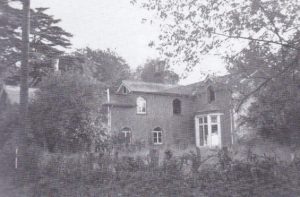
Back with Fenton House and the Denison’s, it certainly looks like Denison still had control of the Wood Leys farm land in 1863, as he was advertising a sale of all his crops in a July edition of the Bedfordshire Mercury. Auctioneer Greene sold off 55 acres of wheat, 19 acres of barley, 20 acres of beans, 16 of Maple peas and 7 of winter Tares at the direction of “W. H. Denison at Wood Ley’s Farm”.
Another name appears as a resident of Fenton House in 1863. Salisbury Payne attended the funeral of Charles Grimshawe of Aspley Guise, the 13-year-old son of C. L. Grimshaw, and Fenton House was given as Payne’s address in the report of the funeral in Croydon’s Weekly Standard of October 3rd. Payne was a J.P. for Bedfordshire.
1868 saw one of the major events in the history of Woburn Sands, when St. Michael’s Church was opened on Aspley Heath. Prior to this, local church-goers had to walk to Wavendon or Aspley, or even over the Heath to Bow Brickhill. William Henry Denison was instrumental in arrangements for some of the parish of Wavendon and some of Aspley Guise being taken to form this new parish. He had been a church warden at Wavendon but switched to the new Woburn Sands church when it opened, a position he held for the next 22 years. His time and efforts were not his only gift to the church, as he gave Fenton House to be the new vicarage, which it would remain for the next 100 years. Wherever Denison was living, he transferred Fenton House on 15th May 1868, so by the time of the 1871 census, it shows the Rev. Hay Erskine in occupation:
Hay Macdowall Erskine, 60, Vicar of Woburn Sands, born Scotland;
Henry D Erskine, Nephew, 32, Land Owner in Scotland, born in India;
Horatia E Erskine, Niece, 28, Marquis’s Daughter, Middlesex;
Ellen Dolton, 39, Cook, Woburn;
Mary Ann McKenzie, 31, Parlour Maid, Eversholt;
Eliza Halliday, 28, Ladies Maid, Liverpool.
By the time of the next census in 1881, the building was referred to as “The Vicarage”, but had changed Vicar:
James M. Hamilton, 48, M A Vicar of Woburn Sands, from Salford, Lancashire;
Elizabeth F. Hamilton, 41, Pendleton, Lancashire;
Margaret Wills, 21, Parlour Maid, Byfield, Northamptonshire;
Sarah A. Peacock, 15, House Maid, Ely, Cambridgeshire.
In 1885, William Henry made another draft will, somewhat simpler than the last. (BARS: HN10/270/Denison4) In it, William Henry Denison “of Woburn Sands, gentleman”, left:
– William Wiggins and Frederic Thomas Tanqueray of Woburn, gentleman to be his executors;
– all real and personal estate to his executors upon trust for his wife for her life, then upon trust for sale with £1,000 to be paid to appointee under the will of his wife, in default equally to his wife’s nephew and niece George Simond Boulger and Mary Sewell Shears; £2,000 to be invested and income paid to his nephew John William Dering Walker for life; with £200 to each executor for his own use; residue to be paid to Anne Arabella Wiggins, wife of William Wiggins
William Henry Denison eventually died in 1890, fittingly whilst attending a service at St. Michael’s church in Aspley Heath. Rev. Michael Meakin wrote a history of St. Michael’s in 1968 for the Church Centenary, and penned this description of his passing, probably from verbal descriptions of the event handed down within the Church:
“On Saturday evening, June 8th 1890, being the First Sunday after Trinity, he was in his place in Church. His white hair and beard contrasted with the sombre black of his clothes. The Service took its course. He sang the Nunc Dimittis. He stood erect and firmly recited the Apostle’s Creed. He knelt down, for old man though he was, he always knelt. He commended himself to God in the words: “Christ have mercy upon us”, and then before his lips could frame the next words – “Our Father, which art in Heaven” – he had gone to his Heavenly home.”
His obituary in the Beds Mercury of 21st June shows just how instrumental he and his family had been in the formation of Woburn Sands:
“Woburn Sands – The Late Mr Denison – The funeral of Mr William Henry Denison, of Hardwicke (who died in St Michael’s on the 8th), took place in the parish churchyard on the 13th. Mr Denison was the second and only surviving of the three sons of the late Rev. W. H. Denison, rector of Cublington, who built and resided at Fenton House, now the Vicarage. Deceased lived there many years, when Hogstye End was almost a barren waste, designated as Woburn Sands. The buildings now the Constitutional Club, were schools formed by Mr & Mrs Denison, who almost alone bore the educational torch, besides establishing clothing clubs and other useful institutions. These rooms, too, were, by their influence, used for church services, the Rev. Henry Burney and the Rev. Charles Mayor (a former curate of the vicar of Wavendon) officiating. Previous to the erection of St. Michael’s, Mr Denison was the Rev. H. Burney’s churchwarden, with the late Mr. James Anderson as parish warden, of Wavendon, whose Vicar had been known to speak of Mr. Denison as “active and energetic, careful, sensible, and judicious, and pleasant to work with.” Wavendon is indebted to him in many ways. The well close to the School-house was sunk at his expense, and the inhabitants were allowed to use it as their own. He caused a footway to be made along the village, carried on to the station and afterwards to Woburn Sands and Woburn. When he succeeded to the “Isaacson property,” he commenced farming on a large scale, making great experiments and spending largely; but he was not successful and eventually sold out. Mr Denison was a Director of the Aspley Guise and Woburn Sands Gas Company, and presented it with the road leading to the works. He was a trustee of the Aspley Benefit Society, and ever ready to be useful – a good, kind, sociable friend. Mr Denison married a Reading lady. They had no children, and his loss to an invalid wife is great indeed. The remains of Mr Denison (aged 79) were conveyed from Hardwicke in an open car, covered with numerous choice wreaths. Shops were closed and blinds drawn as the cortege passed through the village. The mourning coaches contained Mrs Henry Denison (sister-in-law of deceased). Rev. William Denison (nephew), Mr and Mrs Wiggins (nephew and niece), Mrs Channer (niece of Mrs Denison) Mr J. W. Walker (nephew), Miss Tyler, Mrs Charles-Williamson, Mr Tanqueray, Dr. King, Mr Challoner, Mr. Pain, Mr F. G. Sharp (school-master), Mr T. Hudson, and Hardwicke servants. Among others who joined in the procession were Mr and Mrs Pole Stuart, Messrs Whitman, Pickering, Clarke, Sturgess, Goodman, Luttman, Godfrey and Wodhams &c. The corpse was met at the church gate by the Rev. E. Mosse, vicar, preceding the surplice choir, with the Revs. H. Burney, B. Chernocke Smith, W. Barton and J. Milne Hamilton…”
“Now the Labourers Task is O’er” was sung in church and there was then a long list of who had sent wreaths. The piece ends:
“On Sunday morning the Vicar took for his text Psalm xcii., 13-14 and in impassive manner alluded to Mr Denison as a church warden of Wavendon and Woburn Sands for upwards of fifty years, one who had always been a ready Christian helper, kind and benevolent to all and whose last moments on earth had been spent in the House of God he so fondly loved.”
The East Window of the Ascension in St Michael’s was installed as a memorial to him.
Rev. Mosse was incumbent at Fenton House when the 1891 census took place, listed as “The Parsonage”. Quite a full house for a change!
Edward Henry Mosse, 35, Clergy – Vicar of Woburn Sands, from Heage, Derbyshire;
Maria Louisa Mosse, 34, Betchworth, Surrey;
Francis Henry Mosse, 6, Wavendon;
Ewen Field Cameron Mosse, 4, Wavendon;
Helen Margaret Mosse, 2, Wavendon;
Emma Jane Cameron, Sister-in-Law, 39, Betchworth, Surrey;
Maria Shelborne, 50, Cook Domestic Servant, Collingham, Nottinghamshire;
Maria Fanny Woolaston, 26, Nurse Domestic Servant, Cambridge;
Susannah Benstead, 18, Housemaid Domestic Servant, Sandringham, Norfolk.
It appears that for some reason, Rev. Mosse did not want to use the house in the winter of 1894, as it was put up for rent. An advert in The Field, of 29th September, ran:
“TO BE LET, Furnished, for the winter, in a healthy and beautiful neighbourhood, WOBURN SANDS VICARAGE, half a mile from station, and one hour from London; four sitting, seven bedrooms, bathroom &c.; good stabling and garden. – For further particulars apply Messrs WOODFORDS AND WING, Land Agents, Stamford.”
The first census of the new century (1901) saw another new vicar in place, but this time no house name at all was used for the Vicarage:
Douglas William Henry, 40, Clergyman (Church of England), from Brading, Isle of Wight;
Sarah Elizabeth Henry, 36, Reading, Brecknockshire;
Douglas Cecil Henry, 8, Battersea, Middlesex;
Lilian Mary Joyce Henry, 5 months;
Elizabeth Jane Norman, 19, Cook (Domestic), Husborne Crawley;
Edith Truth Norman, 14, Housemaid (Domestic), Husborne Crawley.
He and his family were still there ten years later in the last census we can currently access, 1911. His eldest son had left home, but another had appeared:
Douglas William Henry, 50, Clergyman (Established Church), Brading, Isle of Wight;
Sarah Elizabeth Henry, 46, Brecon;
Lilian Mary Joyce Henry, 10, Student , London Battersea;
Philip Sidney Hillard Henry, 4, Woburn Sands;
Beatrice Louisa Purse , 19, Cook Domestic, Not Known;
Ada Ann Caress, 15, Housemaid Domestic, Pertenhall.
Again, the house was up for rent in June 1909, appearing in an advert in the London Evening Standard, which pointed out that a photo of it could be seen at Harrods! Rev. Henry must have had somewhere else to stay:
“Rent 6 Gns. Per week. Pine Woods – Inland Health Resort; beautiful country and air; two acres grounds; shady lawn, well stocked garden; three reception, eight bed, bath (hot and cold); excellent sanitation and water, coach or motor house, stabling, station, frequent trains, one hour and a quarter London, golf near – Woburn Sands Vicarage, Bucks. Photo at HARRODS (Ltd) Brompton Road. S.W.”
After Rev. Henry came Rev. John Shelton, who steered St Michael’s for 33 years, from 1913 to 1946. During his time, some ground to the south of the house was given for a new church hall. Alfred Pettit had retired to Woburn Sands sometime before the First World War, to a house in Aspley Heath. He was a Churchwarden from 1915 to 1923. When his wife died in 1927, he funded the building of The Ellen Pettit Hall in the grounds of the then Vicarage in her memory. Alfred died in 1934. The Hall, with a raised stage and kitchen facilities, has been the scene of thousands of community events since then, and is also now the home to Woburn Sands Town Council.
After the death of Rev. John Shelton, his effects were sold at Fenton House on 12th June 1946 by local auctioneers, Foll & Parker. This included all his furniture, and 350 lots were put through the sale, including a piano in a walnut case, a ukulele and a Spik dry-cleaning machine. The House was renamed to Shelton House after this beloved vicar, although no-one seems exactly sure when this happened.
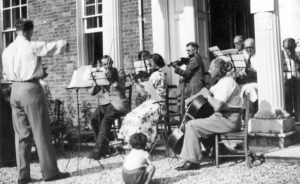
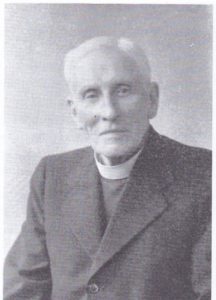
In 1968, the incumbent Rev. Meakin and family moved on from the Woburn Sands vicarage after 17 years, and the Diocese decided to sell Fenton/Shelton House and provide the next vicar with a new bungalow nearer to the church in Aspley Heath. Wright says the old Vicarage building was now “draughty and inconvenient… there were no uniformed maids to answer to the call of the bells which still hung in the old kitchen, and heating the large and lofty rooms became a problem.” So the Meakin family were the last residents before it was turned over to business use.
In 1969, Woburn Sands Parish Council were notified that the Vicarage and hall had been purchased by Newport Rural District Council, who intended to build old people’s bungalows on the Vicarage garden. The Council approached Newport District Council and enquired if the Ellen Pettit hall could be sold to the Parish Council for community use, this was agreed, and so Woburn Sands Parish Council took ownership of the Hall in 1970, and Newport Rural District Council later built a retirement home complex to the west of the house, which was named Shelton Court.
In February 1984, Shelton House was given Grade II listed status, and described as: “House now used as offices. Early C19 altered. Red brick with some blue headers. Hipped slate roof with projecting eaves and panelled soffit. 2 storeys, W. elevation has 5 bays of barred sash windows in reveals with flat gauged brick arches. Central neo-Georgian portico with fluted columns and pilasters, entablature and panelled door surround, panelled double doors, 2 stone steps.”
A financial investment business, the David Aaron Partnership, was based in the building from c.1996, but this ended in 2004 after the Financial Services Compensation Scheme declared them in default. The building is now owned by Heritage Trustees Limited, who administrate pension investments, and several businesses are based in it, principally Kingsley David Solicitors Ltd.
After the Denison’s, Hardwick Cottage was later taken by a Mr Mowbray, who became a churchwarden too, in 1909-1912. His daughters inherited the house and were also great supporters of St. Michael’s. After their passing, it eventually became derelict for some years, before being pulled down c.1960 to make way for the re-routed road to connect to The Leys with Hardwick Road. The area left in the middle between the new road and Hardwick Place was made into an open public space and is now known as Mowbray Green.
When Wavendon Gate was developed, a cul-de-sac of houses off Walton Road was named Denison Court after the family that gave so much to Woburn Sands and Wavendon.
Page last updated Dec 2019.
